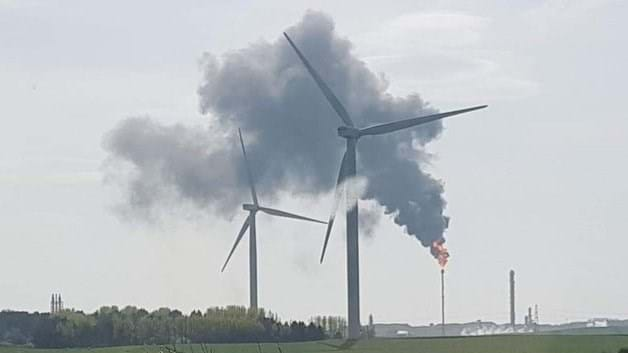ExxonMobil stops unplanned flaring at UK plant

EXXONMOBIL has announced that it has ceased unplanned flaring at its Fife Ethylene Plant (FEP) at Mossmorran, in Fife, UK. The flaring lasted six days and led to record levels of complaints from those living nearby.
The flaring began on 21 April and was halted on 26 April when the plant returned to normal operation. While Exxon said on Twitter that the interruption was caused by a section of cable which was replaced on 21 April, it has not responded to requests from The Chemical Engineer for additional information on the cause of the flaring, why it continued for six days, nor how it was resolved.
Flaring is an important safety mechanism employed in refineries and petrochemical facilities. It is operated under permit conditions. The process is used to burn excess hydrocarbons which cannot be recycled or recovered, as an alternative to releasing the hydrocarbons directly into the atmosphere.
According to the Scottish Environmental Protection Agency (SEPA), though elevated flaring has ceased, Exxon said in a statement that ground flaring would continue at “above normal levels” for a “short period”. At FEP, Exxon typically prefers to use its two low visibility ground flares rather than the elevated flare. According to SEPA, elevated flaring is noisier, and ground flares are usually employed to minimise noise.
On 25 April SEPA announced a formal investigation into the flaring at the plant.
On 29 April SEPA CEO Terry A’Hearn and Jacob McAlister, Exxon Chemicals Plant Manager met for an initial discussion about the event. A’Hearn confirmed the live regulatory investigation, obtained confirmation that Exxon would submit an assessment of best available techniques (BAT) this week, and urged the company to increase direct engagement with local communities. On 1 May SEPA confirmed that it received BAT assessments from Shell and ExxonMobil the day prior.
SEPA began responding to complaints about the incident on 21 April. After the elevated flaring ceased, SEPA maintained “its full operational response including regulatory, air quality and noise monitoring” across the following weekend. The monitoring will inform the agency’s live regulatory investigation.
As of 27 April, SEPA had received more than 750 complaints, one of the highest numbers of complaints received for any single event, it said.
Locals took to Twitter to express anger at the noise pollution, which one user described as sounding like “an aeroplane taking off constantly”, and concerns about the potential impact of the flaring on air quality. BBC News reports that the noise and the light from the flare kept people awake at night and frightened children, and people were concerned by black smoke caused by the flaring.
However, according to a SEPA update on 22 April, air quality monitoring showed that there was “no cause for concern”. Another update of the ongoing monitoring is expected “in the coming days”. The update has not yet been published.
Reportedly, residents as far as Kirkcaldy, Fife reported being affected by the noise, vibrations, and chemical smells from the plant. Kirkcaldy is 11.3 km away from Cowdenbeath, where FEP is located.
A’Hearn said: “Whilst the Mossmorran complex is a major industrial facility where this type of flaring is a legitimate safety mechanism, this is happening too often, and the level and extent of flaring is wholly unacceptable.”
McAlister told BBC News that unplanned flaring at the plant is “very rare”.
He added: “When elevated flaring occurs, we absolutely understand its impact on communities. As such, we will continue to strive to minimise impact by reducing unplanned events and duration.”
Unplanned flaring at Mossmorran
SEPA investigated a number of unplanned flaring events at the Mossmorran Complex in 2017 and 2018. Mossmorran comprises Exxon’s FEP and Shell UK’s Fife Natural Gas Liquids plant.
“SEPA is clear that environmental compliance is non-negotiable,” the agency said. In April 2018 it issued Final Warning Letters to both Exxon and Shell UK for unplanned flaring in June 2017 which SEPA found to be “preventable and unacceptable”.
Following June 2017, there was further unplanned flaring by Exxon in October 2017, March 2018, and May 2018.
In June 2018, SEPA served Exxon and Shell UK notices of variation to their operating permits to ensure that the companies would take all appropriate measures to prevent noise and vibration emissions through application of BAT and to ensure that no significant pollution is caused.
The companies were also required to conduct an assessment of BAT to prevent, or reduce when prevention is not practicable, emissions of noise, vibration, and smoke, due to flaring.
SEPA says that the outcome of the BAT assessment is essential to understanding how unacceptable and preventable impacts of flaring can be stopped.
On 1 May SEPA confirmed that it received BAT assessments from Shell and ExxonMobil the day prior. The agency says that following a review of the proposals it will provide an update on the assessment before a planned community meeting on 17 May which SEPA is to attend.
Recent Editions
Catch up on the latest news, views and jobs from The Chemical Engineer. Below are the four latest issues. View a wider selection of the archive from within the Magazine section of this site.




